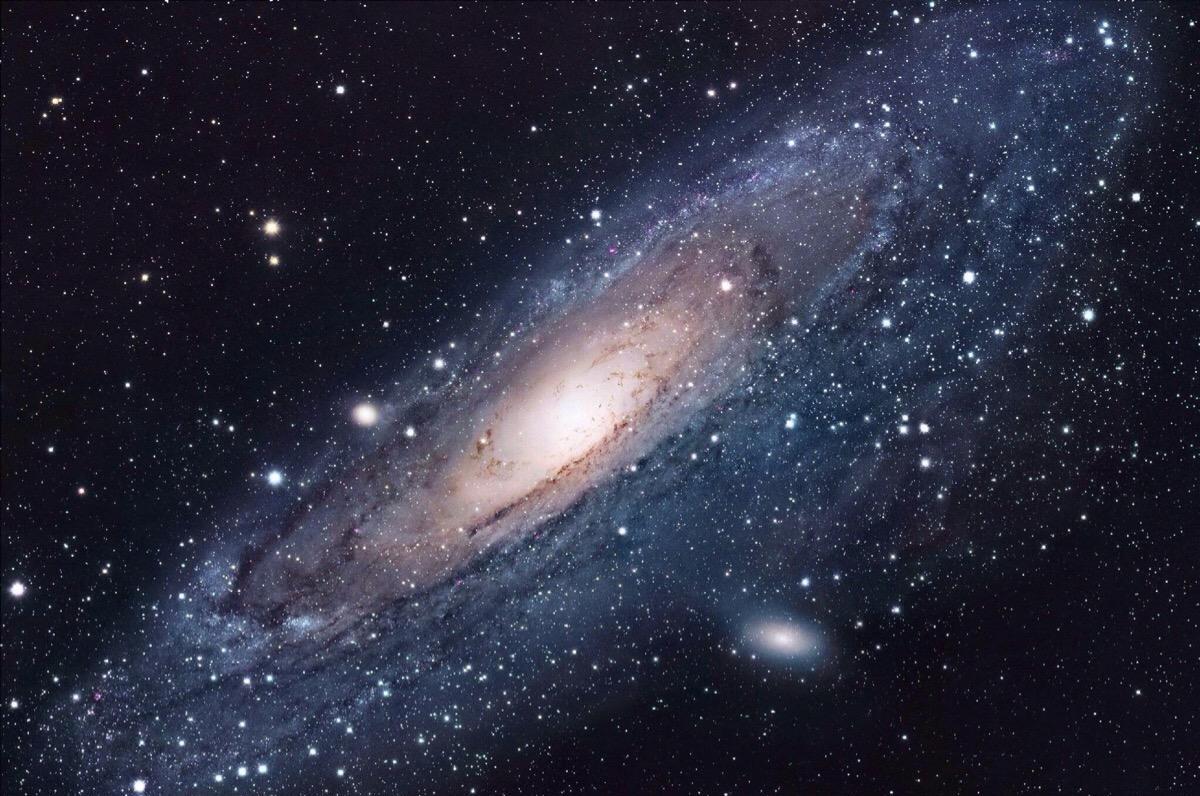
原文 | Indranil Banik, Jan Pflamm-altenburg, Moritz Haslbauer, Pavel Kroupa, Srikanth Togere Nagesh
Translate | Linvo
Astronomers have discovered that there are two main types of galaxies in the universe: elliptical galaxies and spiral galaxies. Elliptical galaxies are dead galaxies filled with very old red stars that move around the center of the galaxy in a disordered orbit, making their shape look like a fluffy soccer ball. Active spiral galaxies, on the other hand, have both old stars and many newly formed stars. They look like beautiful swirls because their stars and gas move along a nearly circular path in the common center of a thin rotating disk. These spiral galaxies extend from the center to a distance of 30,000 light-years or more, while elliptical galaxies have a typical radius of 10,000 light-years. When all galaxies heavier than 10 billion suns are counted, only 3% of galaxies are dead, and the vast majority of galaxies today are spiral galaxies filled with young stars. Our Milky Way is a spiral galaxy like this, and our Sun is about twenty-four thousand light-years from its center.
Our Milky Way galaxy has about 50 billion stars and is constantly forming more stars. About 4 stars are born every year, a phenomenon that has been going on for 12 billion years. But there are also ups and downs, and sometimes the Milky Way produces more stars, sometimes fewer stars, depending on whether nearby galaxies are close or not. The largest galaxy closest to us is the Andromeda Galaxy, which is about 2.2 million light-years away and is approaching us, and it contains more stars but is very similar in other ways.
Stars are formed from the gas contained in these galaxies, but if we calculate all of this gas, it can be estimated that galaxies like ours will run out of gas in 3 billion years. Our sun is 5 billion years old, so the Milky Way should have been completely depleted of gas since the formation of the sun and Earth. However, astronomers see a cloud of gas formed by the star only 300 light-years away, suggesting that the Milky Way is forming stars today as if it weren't consuming its own gas. When considering this fascinating situation, it is necessary for astronomers to develop a theory to understand how gases are replenished and to solve this profound cosmological problem.
Astronomers and physicists today believe that there was a big bang about 13.8 billion years ago that produced all the matter and catalyzed the ever-expanding universe. As the gas cooled after the Big Bang, the first galaxies condensed, thus merging with other galaxies to form the large galaxies we see today. According to this theory, in a typical galaxy, the rate at which new stars are born should have reached their maximum about 8 billion years ago. The production of stars should gradually decrease over time, as the gas in the galaxy is consumed, the supply of new gas from the surrounding environment is exhausted, and the newly merged galaxies are becoming scarcer and rarer in an increasingly diluted universe. Beyond that, dark energy, a largely unknown form of energy, seems to be tearing the universe apart at a much faster rate. So, in theory, galaxies should stop growing.
Big Bang model
A team of astronomers from the University of Bonn and Charles University in Prague now has a strange discovery: They have selected hundreds of galaxies that have been observed up close within 30 million light-years and have tested the above theory. The behavior of galaxies found in this small piece of the universe is very different from the previously mentioned theory because they do not change the rate at which new stars are born. For example, a large galaxy today produces 10 stars a year, and when it was born 12 billion years ago, it also produced 10 stars a year. Today, a smaller galaxy may produce only one star every decade, a rate that hasn't changed since its inception.
This shocking discovery overturns previous assumptions, because it means that when a galaxy was born when it formed its first cluster, the gas it received at the time and the gas it receives today may merge into one, much the same. There is no indication that these galaxies follow the above theory. If anything, the telescope's observations seem to indicate a faint trend, according to which, if anything, is a slight increase in the rate at which new stars are born in galaxies.
Stars that are being born in nebulae
This opens up a new mystery: How do galaxies continue to grow? How does the environment in which a galaxy lives allow this gas to feed the galaxy at an exact rate so that the number of stars born in the galaxy remains the same throughout its 12 billion-year life cycle? Neither astronomers nor physicists know the answer to this question. In fact, since this question is a completely new one, we need to do a lot of original thinking and research in order to answer this question. Some astronomers will try to answer this question with the help of the theory above, but it's not clear how it works because the same theory requires different results for nearby galaxies, and nothing in the theory can do that. Others may try to develop entirely new theories to study how the surrounding space transports gas to its galaxies. The results of this study are still very open, but it is certain that some of our physical theories may fundamentally change.
original:
https://blog.oup.com/2020/09/the-enduring-mystery-of-how-galaxies-grow-up/